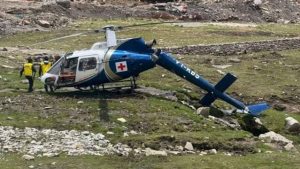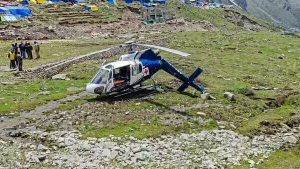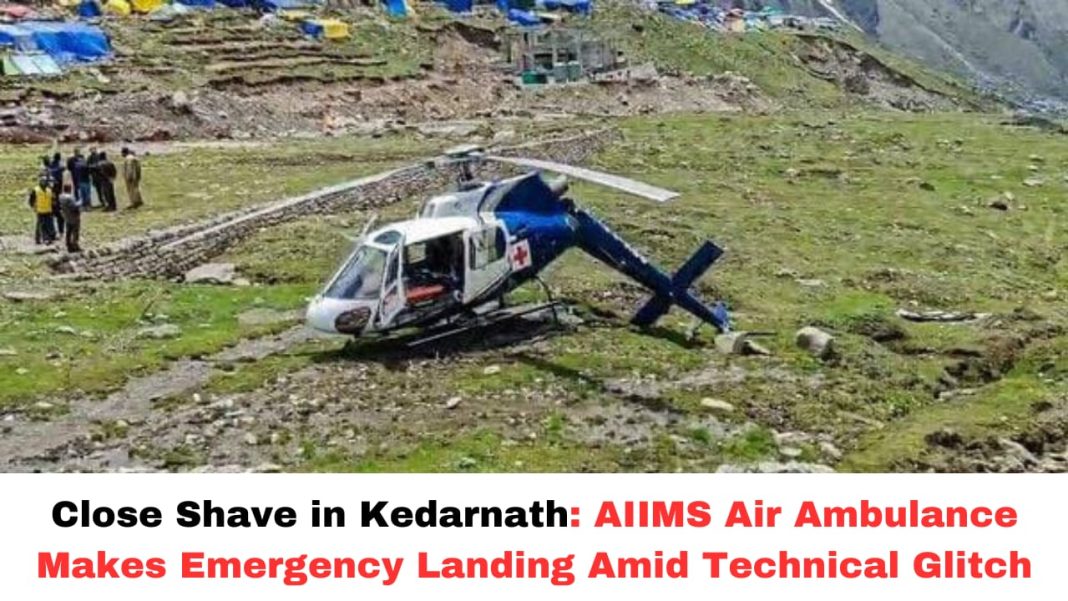Digital News Guru Uttarakhand Desk:
Air Ambulance Incident in Kedarnath
In a harrowing incident amid the ongoing Char Dham Yatra, an AIIMS-Rishikesh-operated ‘Sanjeevani’ air ambulance made an emergency crash-landing near the Kedarnath helipad on Saturday morning, narrowly averting a potential tragedy. The aircraft, experienced a sudden tail rotor malfunction during descent. Swift and decisive action by the pilot ensured the safety of all three individuals on board.
The incident occurred at approximately 11:50 AM on 17 May, just as the helicopter approached the designated landing zone near the Kedarnath temple complex. The tail rotor, a crucial component that maintains the aircraft’s stability, reportedly failed mid-air, causing the helicopter to spin uncontrollably.

As the tail struck the ground, the pilot managed to perform a hard but controlled landing on a flat patch just short of the official helipad. The passengers—a doctor, a nursing officer, and the pilot—miraculously escaped unscathed.
A Mission Turned Emergency
The AIIMS air ambulance was dispatched as part of the government-backed ‘Sanjeevani’ emergency response service, which provides rapid medical support to pilgrims navigating the high-altitude Char Dham pilgrimage circuit. This specific sortie was initiated to rescue a middle-aged male devotee suffering from acute respiratory distress—an increasingly common medical condition in the high altitudes of Uttarakhand’s mountainous terrain.
The patient, who was awaiting evacuation, was eventually stabilized and taken to safety through alternative arrangements. His condition is reported to be stable.
Eyewitness Accounts and Visual Evidence
Videos of the incident quickly circulated on social media and news platforms, capturing the moment the helicopter lost control. The aircraft can be seen spinning 360 degrees on landing, with dust and debris billowing around the helipad. Onlookers, including local security personnel and pilgrims, were seen running for cover as the aircraft veered dangerously before coming to a halt.
Safety Concerns Rise: Third Helicopter Incident in 10 Days
The crash-landing is the third helicopter-related mishap in Uttarakhand in a span of just ten days. Earlier, on May 8, a tragic crash near Gangnani in Uttarkashi district claimed the lives of six individuals, including a pilot and five pilgrims. That incident was attributed to poor visibility and adverse weather conditions. Another rotor blade incident occurred in Badrinath on May 13, though no casualties were reported.

These back-to-back incidents have raised urgent questions about the preparedness and maintenance standards of aviation services operating in the challenging Himalayan region, especially during the high-volume pilgrimage season.
DGCA Orders Technical Probe
The Directorate General of Civil Aviation (DGCA), India’s apex aviation safety authority, has launched a technical investigation into the Kedarnath incident. A team of investigators will examine the helicopter’s maintenance records, flight data, and mechanical systems to determine the precise cause of the tail rotor failure.
The helicopter model used in the AIIMS-Rishikesh fleet is a Eurocopter AS365 Dauphin, widely used in India for VIP and medical transport. It has a generally strong safety record, but incidents in mountainous terrain continue to test even the most reliable aircraft.
‘Sanjeevani’ Heli-Ambulance: A Lifeline Under Scrutiny
Launched in October 2024 by Prime Minister Narendra Modi, the ‘Sanjeevani’ air ambulance service was designed to bridge the healthcare access gap in remote and high-altitude regions of Uttarakhand. Operated in partnership with AIIMS Rishikesh and the Uttarakhand government, the service has been instrumental in saving lives during the Char Dham Yatra and natural disasters.
However, this latest incident places the ambitious project under public and administrative scrutiny.
Operational Challenges in the Himalayas
Aviation experts have long emphasized that flying in the Garhwal Himalayas presents unique challenges: unpredictable weather, rapidly changing wind patterns, and limited emergency landing options. The surge in religious tourism—over 15 lakh pilgrims are expected to visit Kedarnath in 2025 alone—has increased reliance on air support services, often stretching their capacity and safety margins.
The Road Ahead
As investigations continue and safety assessments get underway, experts are calling for better airworthiness checks, pilot re-training programs specific to high-altitude flying, and stricter regulatory oversight. The DGCA is expected to release a preliminary report within 10 days.
In the meantime, the Sanjeevani air ambulance service remains operational, albeit with increased scrutiny and emergency safety audits underway. Pilgrims are being urged to consult with local authorities and medical personnel before undertaking the journey, especially those with underlying health conditions.

Conclusion
The Kedarnath air ambulance incident is a stark reminder of the thin margin for error in life-saving missions conducted in India’s most remote and unforgiving regions. That no lives were lost is a testament to the pilot’s quick decision-making and the resilience of the crew. As India balances the spiritual fervor of the Char Dham Yatra with the realities of modern aviation, the focus must now shift to prevention, preparedness, and the pursuit of safety—at all altitudes.
You May Also Read: Shah Rukh Khan and Rani Mukerji Reunite in Siddharth Anand’s ‘King’








